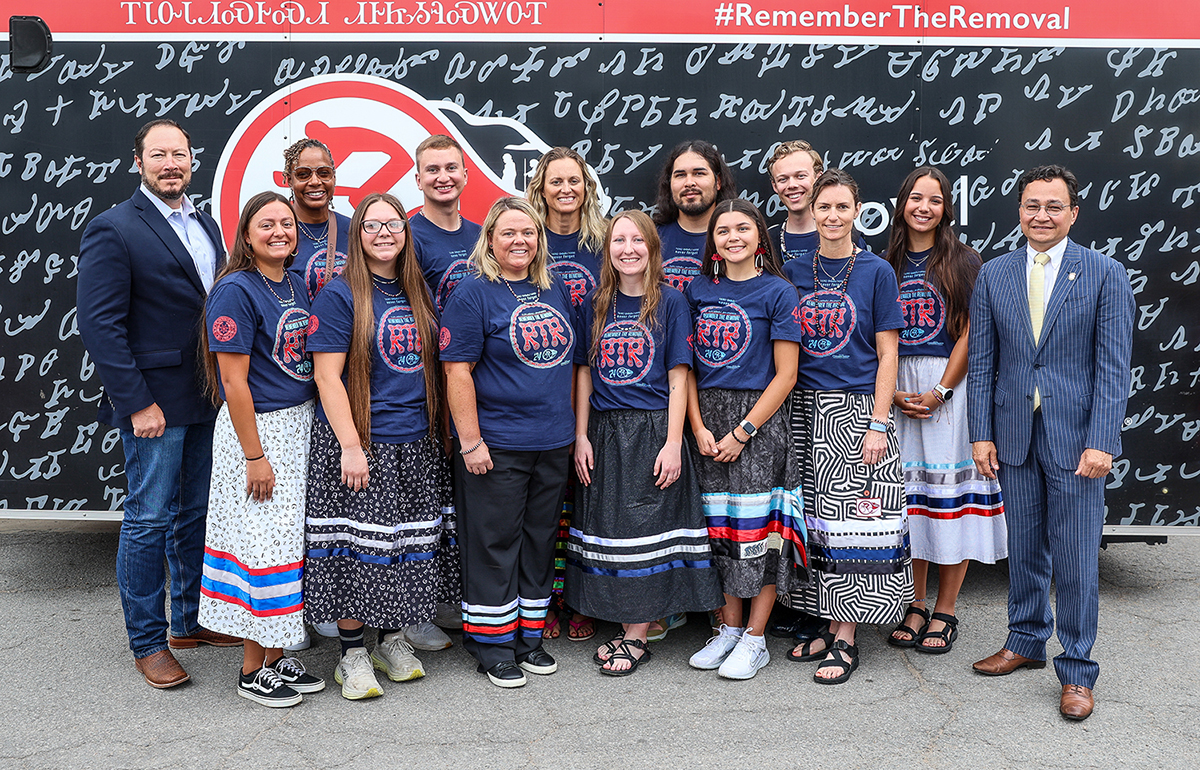TAHLEQUAH, Okla. — The 12 Cherokee Nation Remember the Removal Bike Ride participants left for Cherokee, North Carolina, on May 28, following a send-off ceremony at the Cherokee Nation W. W. Keeler Tribal Complex.
Principal Chief Chuck Hoskin Jr., Deputy Principal Chief Bryan Warner and other Cherokee Nation leaders joined members of the Council of the Cherokee Nation and family, friends and co-workers of the 12 cyclists to share well-wishes ahead of their weeks-long journey. The cyclists will join participants from the Eastern Band of the Cherokee Indians in North Carolina later this week to train before their ride officially begins June 3.
“I’m excited to celebrate such a tremendous occasion again this year,” said Chief Hoskin. “The send-off of 12 Cherokee citizens reminds us of the experiences of our ancestors. They endured one of the darkest chapters in the history of the Cherokee Nation. The ride serves as a tool to remind us of that chapter and gives an excellent opportunity to these riders to show them the strength and perseverance that they come from. Visiting historical sites that some wanted to be the closing chapter on our Nation is a stark reminder of the stain of the Indian Removal Act that so many suffered from.”
The Remember the Removal Bike Ride spans approximately 950 miles along the northern route of the Trail of Tears, beginning in New Echota, Georgia, the former capital of the Cherokee Nation, and ending on June 21 in Tahlequah. The northern route of the Trail of Tears spans through Georgia, Tennessee, Kentucky, Illinois, Missouri, Arkansas and Oklahoma. This year marks the 40-year anniversary since the inaugural RTR in 1984.
“Seeing another group of Cherokees embarking on this journey is very special,” said Deputy Chief Bryan Warner. “We will pray for protection and healing for all riders on this journey. It takes endurance to train for months while studying our history and language for such a journey. Coming face-to-face with places where so many of our ancestors and family passed is difficult. I have no doubt they are well-prepared with peace in their hearts.”

Cherokee Nation cyclists include Taylor Armbrister, 25, of Little Kansas; Jaslyn Christie, 19, of Park Hill; Camerin Fite James, 24, of Fort Gibson; Jasmine Goodman, 24, of Fort Gibson; Kiyah Holmes, 24, of Muskogee; Lexi Melton, 23, of Vinita; Hannah Neugin, 19, of Lost City; Jaxen Smith, 22, of Tahlequah; mentor rider Shawna Baker, 46, of Tulsa; mentor rider Heather Fite, 46, of Fort Gibson; mentor rider Ashawna Miles, 50, of Tahlequah; and mentor rider Kristy Ross, 49, of Locust Grove.
“I wanted to do this bike ride for my family,” said Neugin. “I’m also a descendant from the last survivor of the Trail of Tears. This will be in honor of my family and ancestors who came before me.”
Before leaving, the cyclists had their family trees mapped out by a professional genealogist, providing them insight into their ancestral past as well as connecting any family links they might share with one another.
“I wanted to learn more about my ancestors and make them proud,” said Christie. “I am here to push myself and show myself that I can do this and endure this experience.”
During the bike ride, cyclists will visit several Cherokee gravesites and historic landmarks. Among the sites is Blythe Ferry in Tennessee on the westernmost edge of the old Cherokee Nation, as well as Mantle Rock in Kentucky, where Cherokees spent several weeks during the harsh winter of 1838-1839 waiting for the Ohio River to thaw and become passable.
“Looking at my personal genealogy shows I’m the seventh-generation descendant from those who walked the trail, said Baker. “For me I would say I’m making my ancestors proud by serving on the Supreme Court of the same Nation that rebuilt itself after removal. It’s important for me to remember that our supreme court began in the 1820s prior to our first constitution in the eastern lands, prior to our first unified Chief, Chief John Ross. It’s important to go see the places where this system arose and to be able to trace that movement to our new homelands.”
Of the estimated 16,000 Cherokees forced to march to Indian Territory in the late 1830s, about 4,000 died due to exposure, starvation and disease, giving credence to the name Trail of Tears.
For more information on the Remember the Removal Bike Ride or to follow along during the journey, visit Facebook.com/removal.ride.
Following Tuesday's send-off, the tribe also debuted a short documentary about the inaugural Remember the Removal Bike Ride during a special showing for the 1984 cyclists and their friends and family. The documentary is available to watch online by visiting https://youtu.be/8pR9IQptHvw.

